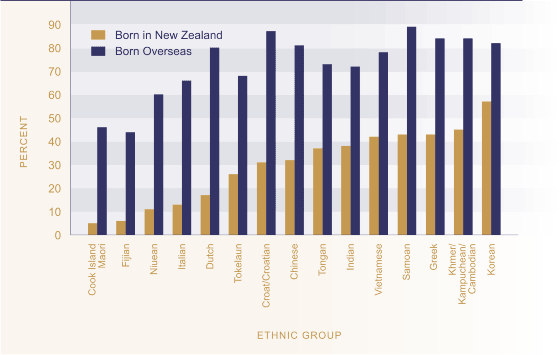Relevance
The ability to speak the language of one's identified ethnicity is an indicator of the ability to retain and pass on one's culture and traditions to future generations. Language is a central component of cultural identity.
Current Level
In 2001, the proportion of people who could hold an everyday conversation in the 'first language' of their ethnic group varied widely between ethnic groups, from 17 percent of Cook Island Māori to 81 percent of Koreans. In all ethnic groups, those who were born in New Zealand were less likely to be able to speak the 'first language' than those who were born overseas.
Figure CI3.1 Proportion of people who
could speak the 'first language' of their ethnic group, by birthplace,
2001 Born in New Zealand 
Source: Statistics New Zealand,
2001 Census, unpublished data.
Age And Sex Differences
In all ethnic groups, young people were less likely than older people to be able to hold an everyday conversation in the 'first language' of their ethnic group. The proportions were similar for males and females.
Table CI3.1 Proportion of people in selected ethnic groups who can speak the 'first language' of their ethnic group, by age group and sex, 2001
| Age (years) | Sex | Total | ||||
|---|---|---|---|---|---|---|
| 0-24 | 25-49 | 50+ | Males | Females | ||
% |
% |
% |
% |
% |
% |
|
| Pacific peoples | ||||||
| Samoan | 50 | 75 | 89 | 61 | 64 | 62 |
| Cook Island Māori | 7 | 26 | 53 | 16 | 18 | 17 |
| Tongan | 44 | 66 | 73 | 53 | 54 | 54 |
| Tokelauan | 27 | 57 | 76 | 38 | 43 | 40 |
| Niuean | 13 | 38 | 61 | 24 | 27 | 26 |
| Fijian (except Fiji Indian/Indo-Fijian) | 14 | 36 | 50 | 26 | 26 | 26 |
| Asian | ||||||
| Indian | 50 | 70 | 74 | 61 | 63 | 62 |
| Chinese | 59 | 75 | 82 | 67 | 71 | 69 |
| Khmer/Kampuchean/Cambodian | 67 | 85 | 87 | 73 | 79 | 76 |
| Vietnamese | 60 | 82 | 84 | 69 | 74 | 72 |
| Korean | 78 | 84 | 84 | 80 | 82 | 81 |
| European | ||||||
| Dutch/Netherlands | 21 | 63 | 81 | 59 | 60 | 59 |
| Greek (incl Greek Cypriot) | 27 | 73 | 89 | 64 | 61 | 63 |
| Croat/Croatian | 41 | 70 | 81 | 66 | 63 | 65 |
| Italian | 13 | 44 | 70 | 39 | 35 | 37 |
Source: Statistics New Zealand, 2001 Census, upublished data.
